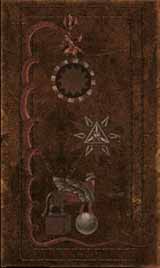 |
1 = Your first move |
The 'Four Knight's Defense' is created after a common chess opening -
not only because I'm so fond of chess, but for the simple fact that chess is a
fine abstraction of common human relationship.
When meeting any person in any situation the 'opening' is important: What is my
first move? How will the other one react or take it? What is my second move?
How will the 'board' i.e. the situation look for me?
Like in life, a good chess opening can decide over the whole game, on the other
hand a messed up opening is hardly to 'repair' later on.
The 'Four Knight's Defense' is a very useful spread when you want to shed some
light on your relation to a person or a meeting with a person or situation. It
is also helpful when you want to know more about your position or your chances
regarding a person or situation.
![]()
Card 1 is your first move, your first step towards the other person (or
towards the situation).
Card 2 is the first move of the other one, the response from the other person
to your first move, or the effect that your move has to the situation.
Up to now, the situation is simple, there is no direct confrontation, no-one
threatens or controls the other, no-one 'rules the game'. It is more like 'here
am I, there are you' - the first look and hello, so to say.
Card 3 is your first 'knight' i.e. a stronger power that you set up for your
second move.
In chess, this move means that your knight threatens and controls the piece the
opponent has first moved. Now in life we are a bit more peaceful, and a winning
in human relationship doesn't necessarily mean that we have successfully kicked
the other(s) off the board.
So you can see your 'knight' in here more as your appropriate reaction, your
move to strengthen and undermine your position.
But of course - when you do the spread for a hostile or negative
relation/situation, you can very well see it more 'chesslike'.
Card 4 is the other one's first 'knight' that comes out in direct response to
your first knight.
In chess, the opponent's knight comes out in order to protect the piece your
knight could attack. In our peaceful world of human relations, we see this
knight as the other one's intention to strengthen and undermine his/her
position. In further process, card 4 will represent the direct answer you will
have to face when doing further steps with your 'knight' in card 3.
Card 5 is your second 'knight', your back-up and your reserve potential. It
also can stand for the feelings you keep back or hide from being exposed too
early.
Card 6, logically, is the other one's second 'knight' and reserve potential,
and might also represent the feelings that the other one keeps behind.
![]()
As you can see in the model at the top of this page, the 'Four Knight's
Defense' is very complex and all cards stand in manifold relations to each
other. The lower half (cards 1,3 and 5) represent your side, the upper half
(cards 2,4 and 6) represent the other one or the situation you have to face.
All three cards of each side will support each other, back up each other, and
appear as a combined unit.
Nevertheless, while reading you shouldn't forget that your cards 'provoke' the
other side's cards.
 |
When using the
'2-birds-system', the position of the six cards are like in the model aside.
|
Now you can display your cards here.
As you see, the cards in the Shuffle Window have their numbers on their backs,
so it is easy to choose the right ones from the dropdown lists. Just take care
you have them in the right order.
Please note that the 'Four Knight's Defense' has a specific order to open and
lay the cards, and the card's positions are important.
So take care that you don't mix them up, and have a look at the model at the
top of the page when you're not sure anymore.
|

